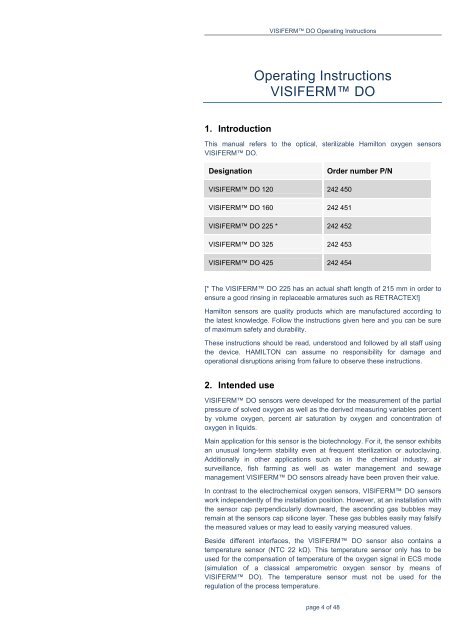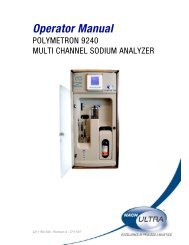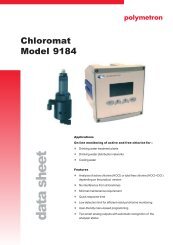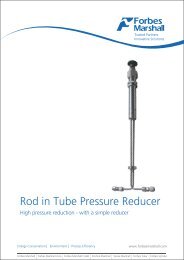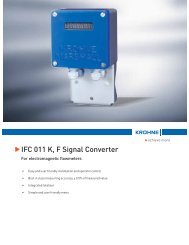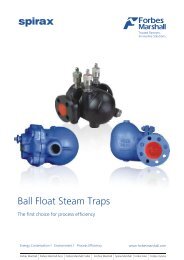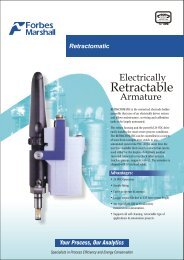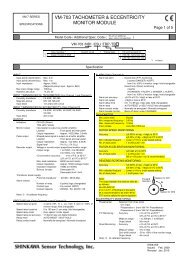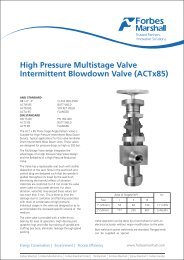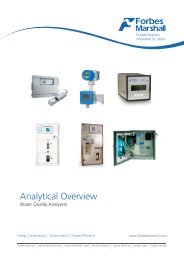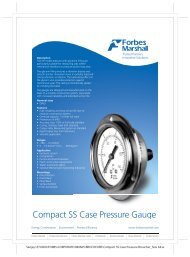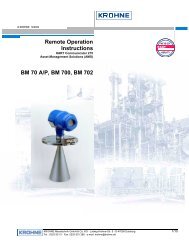visiferm™ do sensors - Forbes Marshall
visiferm™ do sensors - Forbes Marshall
visiferm™ do sensors - Forbes Marshall
You also want an ePaper? Increase the reach of your titles
YUMPU automatically turns print PDFs into web optimized ePapers that Google loves.
1. Introduction<br />
VISIFERM DO Operating Instructions<br />
Operating Instructions<br />
VISIFERM DO<br />
This manual refers to the optical, sterilizable Hamilton oxygen <strong>sensors</strong><br />
VISIFERM DO.<br />
Designation Order number P/N<br />
VISIFERM DO 120 242 450<br />
VISIFERM DO 160 242 451<br />
VISIFERM DO 225 * 242 452<br />
VISIFERM DO 325 242 453<br />
VISIFERM DO 425 242 454<br />
[* The VISIFERM DO 225 has an actual shaft length of 215 mm in order to<br />
ensure a good rinsing in replaceable armatures such as RETRACTEX!]<br />
Hamilton <strong>sensors</strong> are quality products which are manufactured according to<br />
the latest knowledge. Follow the instructions given here and you can be sure<br />
of maximum safety and durability.<br />
These instructions should be read, understood and followed by all staff using<br />
the device. HAMILTON can assume no responsibility for damage and<br />
operational disruptions arising from failure to observe these instructions.<br />
2. Intended use<br />
VISIFERM DO <strong>sensors</strong> were developed for the measurement of the partial<br />
pressure of solved oxygen as well as the derived measuring variables percent<br />
by volume oxygen, percent air saturation by oxygen and concentration of<br />
oxygen in liquids.<br />
Main application for this sensor is the biotechnology. For it, the sensor exhibits<br />
an unusual long-term stability even at frequent sterilization or autoclaving.<br />
Additionally in other applications such as in the chemical industry, air<br />
surveillance, fish farming as well as water management and sewage<br />
management VISIFERM DO <strong>sensors</strong> already have been proven their value.<br />
In contrast to the electrochemical oxygen <strong>sensors</strong>, VISIFERM DO <strong>sensors</strong><br />
work independently of the installation position. However, at an installation with<br />
the sensor cap perpendicularly <strong>do</strong>wnward, the ascending gas bubbles may<br />
remain at the <strong>sensors</strong> cap silicone layer. These gas bubbles easily may falsify<br />
the measured values or may lead to easily varying measured values.<br />
Beside different interfaces, the VISIFERM DO sensor also contains a<br />
temperature sensor (NTC 22 kΩ). This temperature sensor only has to be<br />
used for the compensation of temperature of the oxygen signal in ECS mode<br />
(simulation of a classical amperometric oxygen sensor by means of<br />
VISIFERM DO). The temperature sensor must not be used for the<br />
regulation of the process temperature.<br />
page 4 of 48


